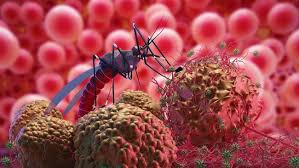The Relationship Between Home Environmental Conditions and Knowledge about Dengue Fever and the Presence of Aedes Sp. Larvae
DOI:
https://doi.org/10.31965/jtdhs.v4i1.2235Keywords:
knowledge about dengue fever, knowledge, Dengue Hemorrhagic Fever, Aedes sp. larvaeAbstract
Dengue Hemorrhagic Fever (DHF) is an acute febrile disease caused by the dengue virus, which enters the human bloodstream through the bite of mosquitoes of the genus Aedes, Aedes aegypti or Aedes albopictus. The purpose of this study was to determine the relationship between home environmental conditions and knowledge about dengue hemorrhagic fever with the presence of Aedes sp larvae. In this study, researchers used an analytical research type that aims to determine the relationship between independent variables and dependent variables. This research design is a cross-sectional study where independent variables and dependent variables are studied simultaneously. The research variables are environmental conditions which include the type of landfill, location of the landfill, condition of the landfill, number of landfills, lighting, ventilation, respondent knowledge and the presence of Aedes sp larvae. The method used to observe the presence of larvae in containers was visual inspection. The population in this study was all houses in RT 18, Oesapa Village, including those with dengue fever cases (6 cases) in 2022 and those without. The sample size was the total number of houses in RT 18, which is 42. Respondents were housewives or family members responsible for housekeeping. Data analysis used a chi-square test with a significance level of p>0.05 (95% confidence interval). The results of this study indicate that factors associated with the presence of larvae include the type of landfill (p = 0.000), the number of landfills (p = 0.005), and ventilation (p = 0.000). Other variables examined that were not related to the presence of larvae included the location of the landfill, its condition, lighting, and respondents' knowledge. Community efforts to control larvae include installing wire mesh over each ventilation hole and regularly emptying the landfill at least once a week.
Downloads
References
Aniq, L. (2019). Hubungan Karakteristik Kontainer Dengan Keberadaan Jentik Aedes Agypti Di Wilayah Endemis Dan Non Endemis.
Azzahra, S. A., Bujawati, E., & Mallapiang, F. (2016). Gambaran Pengetahuan Sikap dan Tindakan Masyarakat di Kelurahan Antang Kec. Manggala RW VI Tentang Penyalik Demam Berdarah Dengue (DBD) Kota Makassar. Higiene, 2(3), 141–147. https://journal.uin-alauddin.ac.id/index.php/higiene/article/download/1823/2233
Badriah, L. (2019). Hubungan Pengetahuan, Sikap Dan Karateristik Tempat Perindukan Nyamuk Dengan Keberadaan Jentik Aedes aegypti Di Desa Sedarat Kecamatan Balong Kabupaten Ponorogo. Kesehatan Masyarakat. http://repository.stikes-bhm.ac.id/598/1/1.pdf
Desniawati, F. (2014). Pelaksanaan 3M Plus Terhadap Keberadaan Larva Aedes sp Di Wilayah Kerja Puskesmas Ciputat Kota Tangerang Selatan Bulan Mei-juni 2014. In Kesehatan Masyarakat. https://repository.uinjkt.ac.id/dspace/bitstream/123456789/26085/1/FARADILLAH DESNIAWATI-fkik.pdf
Fitria, R. (2021). Hubungan Faktor Lingkungan Fisik Dan Tindakan Masyarakat Dengan Kejadian Demam Berdarah Dengue Di Wilayah Kerja Puskesmas Sering. UIN Sumatera Utara, 21–23. https://www.ptonline.com/articles/how-to-get-better-mfi-results
Hidayani, W. R. (2020). Perilaku Ibu Rumah Tangga dalam Pemberantasan Sarang Nyamuk dan Program Penanggulangan Demam Berdarah Dengue. Paper Knowledge . Toward a Media History of Documents, 1(1), 1–20. https://www.researchgate.net/publication/349015661_DEMAM_BERDARAH_DENGUE_Perilaku_Rumah_
Hidayati, Y. (2017). Hubungan Antara Tempat Perkembangbiakan Nyamuk Aedes sp Dengan Kasus Demam Berdarah Dengue Di Kecamatan Rajabasa Bandar lampung. In Pendidikan Biologi (pp. 1–83). http://repository.radenintan.ac.id/3112/1/SKRIPSI_PDF.pdf
Islammia, D., Rumana, N., Indawati, L., & Dewi, D. (2019). Karakteristik Pasien Demam Berdarah Dengue Rawat Inap di Rumah Sakit Umum UKI Tahun 2020. Africa’s Potential for the Ecological Intensification of Agriculture, 1(1), 60–70.
Kemenkes RI. (2017). Pedoman Pencegahan dan Pengendalian Demam Berdarah Dengue di Indonesia. Pedoman Pencegahan Dan Pengendalian Demam Berdarah Di Indonesia, 5(2), 120–121. w.kesehatanlingkungan.com/2019/02/buku-pedoman-pencegahan-dan.html Kemenkes RI. (2021). Profil Kesehatan Indo-nesia. In Pusdatin.Kemenkes.Go.Id. https://www.kemkes.go.id/downloads/resources/download/pusdatin/profil-kesehatan-indonesia/Profil-Kesehatan-2021.pdf
Kemenkes RI. (2017). Pedoman Pencegahan dan Pengendalian Demam Berdarah Dengue di Indonesia. Pedoman Pencegahan Dan Pengendalian Demam Berdarah Di Indonesia, 5(2), 120–121. w.kesehatanlingkungan.com/2019/02/buku-pedoman-pencegahan-dan.html
Kemenkes RI. (2021). Profil Kesehatan Indo-nesia. In Pusdatin.Kemenkes.Go.Id. https://www.kemkes.go.id/downloads/resources/download/pusdatin/profil-kesehatan-indonesia/Profil-Kesehatan-2021.pdf
Mayssara, A. (2014). Pemanfaatan Sistem Inferensi fuzzy dalam Pengelolaan Peta Tematik (studi kasus: sistem informasi geografis daerah rawan demam berdarah). Paper Knowledge . Toward a Media History of Documents, 60–63.
Mulyani, L., Setiyono, A., & Faturahman, Y. (2022). Hubungan Faktor Lingkungan Fisik Rumah, Volume Kontainer Dan Faktor Perilaku Pemberantasan Sarang Nyamuk Dengan Keberadaan Jentik Nyamuk Aedes sp. Kesehatan Komunitas Indonesia, 18(2), 448–466. https://jurnal.unsil.ac.id/index.php/jkki/article/download/5611/2277
Pertiwi, W. E., & Bustomi, S. (2021). Karakteristik Tempat Penampungan Air Bersih dengan Keberadaan Jentik Nyamuk Aedes Aegypti. Of Health Science Community, 2(2), 9–17. https://thejhsc.org/index.php/jhsc
Praditya, I. (2014). Perilaku 3M Plus Ibu Rumah Tangga dan Kondisi Lingkungan Terhadap Kepadatan Larva Aedes Aegypti. Fakultas Kedokteran Dan Ilmu Kesehatan Universitas Islam Negeri Syarif Hidayatullah Jakarta, 9(4), 118. https://repository.uinjkt.ac.id/dspace/bitstream/123456789/25550/1/ILHAM EKA PRADITYA - fkik.pdf
Pratiwi, F. (2018). Hubungan Kondisi Lingkungan, Kontainer, dan Perilaku Masyarakat dengan Keberadaan Jentik Nyamuk Aedes Aegypti di Daerah Endemis Dengue Surabaya. Jurnal Kesehatan Masyarakat, 5(1), 170. https://digilib.esaunggul.ac.id/public/UEU-Undergraduate-12806-JURNAL 2.Image.Marked.pdf
Purnama, G. (2017). Pengendalian Vektor. Fakultas Kedokteran Universitas Udayana. https://simdos.unud.ac.id/uploads/file_pendidikan_dir/22d82a3dbab6e380e1aaf347e86dc055.pdf
Rueda, L. M. (2004). Zootaxa 589. Magnolia Press. https://www.mapress.com/zootaxa/2004f/zt00589.pdf
Suardamana, K. (2018). Demam berdarah dengue (Issue 1102005225). Fakultas Kedokteran Universitas Udayan. https://erepo.unud.ac.id/id/eprint/20537
Sukowinarsih, T. E., & Cahyati, W. (2010). Hubungan Sanitasi Rumah Dengan Angka Bebas Jentik Aedes aegypti. Jurnal Kesehatan Masyarakat, 6(1), 30–35. https://media.neliti.com/media/publications/25298-ID-hubungan-sanitasi-rumah-dengan-angka-bebas-jentik-aedes-aegypti.pdf
Usnawati, S. (2019). Epidemiologi Demam Berdarah Dengue. In Epidemiologi Demam Berdarah Dengue. https://repository.unmul.ac.id/handle/123456789/3760
Wanti, & Darman, M. (2014). Tempat penampungan air dan kepadatan jentik Aedes sp . di daerah endemis dan bebas demam berdarah dengue. Jurnal Kesehatan Masyarakat Nasional, 9(2), 171–178. https://journal.fkm.ui.ac.id/kesmas/article/download/514/444
Zulaikhah, U. (2014). Hubungan pengetahuan masyarakat terhadap praktik pencegahan demam berdarah dengue pada masyarakat di RW 022 kelurahan pamulang barat. Jurnal Ilmu Keperawatan UIN Syarif Hidayatullah, 1(2), hal.10-18. https://repository.uinjkt.ac.id/dspace/bitstream/123456789/25695/1/UMMI ZULAIKHAH - fkik.pdf

Downloads
Published
How to Cite
Issue
Section
License
Copyright (c) 2025 Journal of Tropical Diseases and Health Science

This work is licensed under a Creative Commons Attribution-ShareAlike 4.0 International License.





